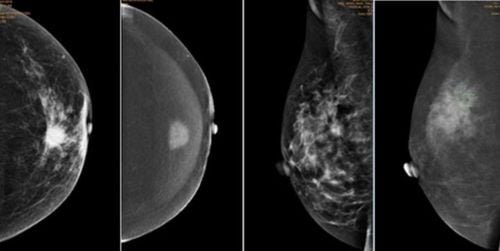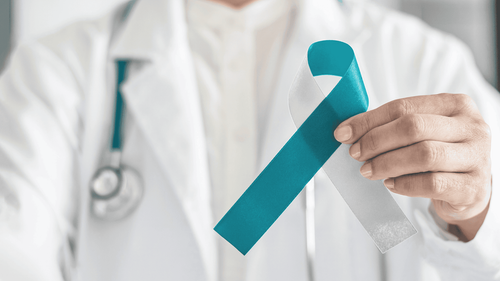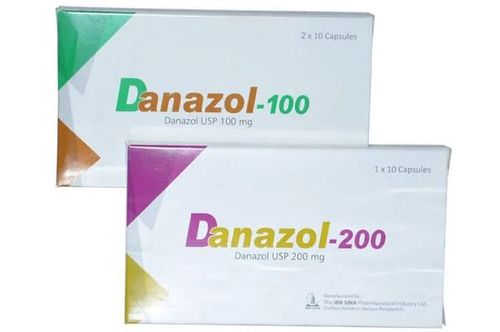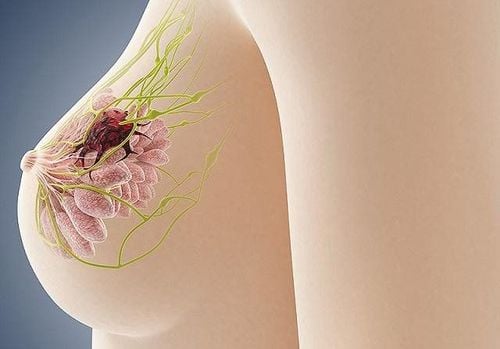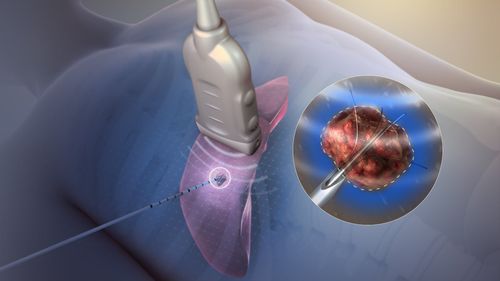This is an automatically translated article.
Fibroids are usually painless, feel like a marble inside the breast, easy to move. This is a type of benign breast lump that does not turn into cancer but is very common in young women.
1. What is a giant fibroadenoma of the breast?
Fibrocystic breast tumors are common in women between the ages of 18 and 40. Most of these tumors are benign and do not turn into cancer.
Fibrocystic tumors are usually firm, hard, smooth in appearance, and well-defined. The tumor is painless, feels like a marble inside the breast, and is easy to move under the skin during examination. Fibrocystic breast tumors vary in size and may enlarge or shrink on their own. There may be one or more fibroadenomas in one or both breasts.
Giant fibroadenoma: A fibroadenoma of the breast that can grow larger than 5 cm. Should be removed as it will compress or displace other breast tissue. The tumor grows rapidly, causing pain and imbalance in the breasts.
2. Manifestations of fibrocystic breast disease
In normal women, breast tissue often feels lumpy. See a doctor right away if:
A new tumor is discovered. Notice a change in your breast. The breast lump you were previously examined for grows or has other changes and appears separate from the surrounding breast tissue. Fibroadenomas are solid breast tumors and are usually:
Smooth margins, well-defined margins Easy to move Firm or firm Painless.
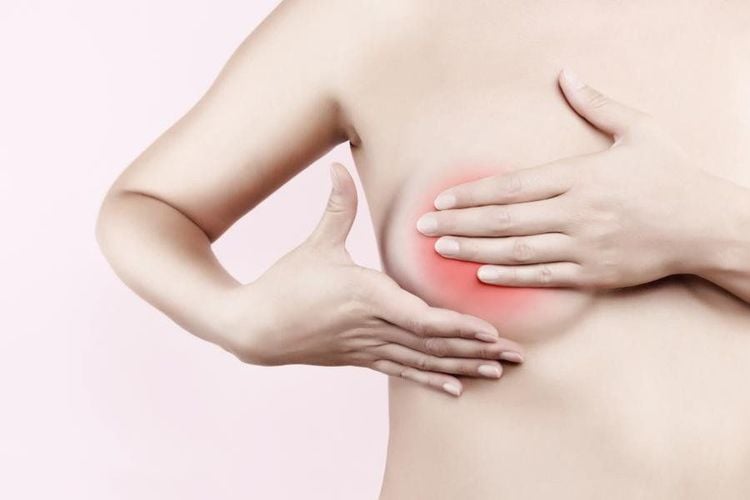
Phụ nữ cần được đi khám bác sĩ ngay nếu phát hiện ra một khối u mới
3. Causes of fibrocystic breast disease
The causes of fibroadenomas are unknown, but they are related to sex hormones. Fibroadenomas are common in reproductive age, may grow larger during pregnancy or hormone therapy, and may shrink after menopause, when hormone levels decrease.
Solid, hormone-sensitive tumors, especially estrogen, originating in the epithelium of the muscle structures located adjacent to the milk ducts outside the lobules. This tumor invades surrounding tissues, pushing those tissues aside without invading them.
4. Complications and harms of giant fibroadenoma
Most fibroadenomas, especially giant fibroadenomas, do not cause breast cancer. However, the tumor grows quickly, causing pain and imbalance in the breasts, which can cause large swelling and pain.
5. Diagnosis of giant fibroadenoma
During the exam, the doctor will check both breasts for lumps and other problems. Some fibroadenomas are too small to feel, so they can only be detected through imaging.
In the case of giant fibroadenoma, your doctor will recommend tests or procedures, depending on your age and the nature of the tumor:
5.1 Mammogram Mammogram uses x-rays to create pictures (mammograms) of areas of breast tissue where a tumor is suspected. A fibroadenoma may be shown on a mammogram as a breast mass with a smooth, rounded margin that is separate from surrounding breast tissue.
5.2 Breast ultrasound Uses sound waves to create an image of the inside of the breast. Your doctor may suggest adding a breast ultrasound in addition to a mammogram to evaluate for a breast lump if your breast tissue is too dense.
For women under 30 with a breast lump, your doctor will likely recommend a breast ultrasound first to evaluate the lump.
If a mammogram only shows that you have a lump in your breast or other abnormalities in the breast, a breast ultrasound can also help evaluate the tumor more comprehensively. Breast ultrasound helps determine if the lump is a solid mass or contains fluid. Since a solid mass is more likely to be a fibroadenoma, while a fluid-filled mass is more likely to be a cyst.
5.2 Fine Needle Biopsy (FNA) Fine Needle Biopsy (FNA) is where the doctor inserts a fine needle into the breast and withdraws the contents of the tumor. If fluid is drained, the lump could be a cyst.
5.3 Core Needle Biopsy (CNB) The doctor, with guidance from the mammogram and from the ultrasound image, will use the core needle to take a tissue sample from the tumor, which is then brought to a laboratory for analysis. .
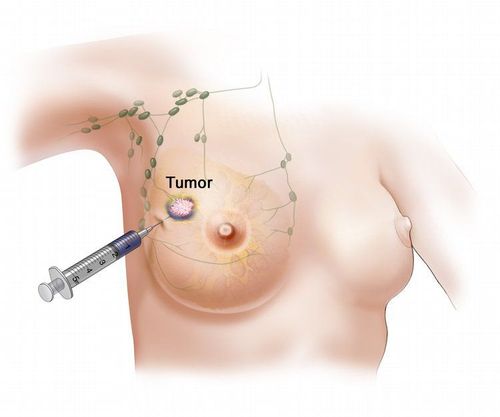
Sinh thiết kim nhỏ là dùng một cây kim nhỏ đâm vào vú và rút thành phần chứa bên trong khối u ra
6. Treatment methods for fibroadenomas
Treatment of fibroadenomas may include: monitoring to detect changes in size and sensation, biopsy to evaluate the tumor, or surgery to remove it.
If the fibroadenoma is < 2cm in size and painless, the doctor only needs to follow up with clinical examination, ultrasound and mammography when accurately identified by fine-needle biopsy (FNA), not necessarily surgery.
When fibroids are >3 cm, minor surgery can be performed, surgery according to the areola line to keep the aesthetics, can also be treated with medical treatment in some cases.
In case of giant fibroadenoma, the patient needs to be treated surgically. Procedures to remove fibroadenomas include:
T surgery to remove the tumor only or excisional biopsy. In this procedure, the surgeon removes the tumor and sends breast tissue to a laboratory to check for cancer. Thermodynamic technique: The doctor inserts a thin, rod-shaped device through the skin to the fibroadenoma. Cold nitrogen gas is injected to freeze and destroy the tissue. Burn with cold heat or burn with high frequency waves. The doctor will use an ultrasound probe to pinpoint the exact location of the tumor and then apply too low or too high a temperature directly to the tumor to destroy tumor cells. Treatment of benign breast tumor removal by biopsy technique with the aid of vacuum aspiration device under ultrasound guidance: Instead of having to open surgery to conduct biopsy, with VABB, the doctor will insert the needle of the machine. into the patient's breast and use vacuum to cut and suck the patient tissue sample out and take it for cytology analysis. This biopsy is done under ultrasound, emulsion, or MRI guidance. Currently, Vinmec International General Hospital applies the treatment of benign breast tumors with the biopsy technique of the ultrasound-guided vacuum suction device (VABB), which has opened a new direction. overcome the disadvantages of traditional surgical methods. Thanks to this method, the patient will be less painful and leave no scars. Especially, it does not cause breast deformity, does not require hospitalization. The patient does not need to undergo many incisions to remove the tumor, but only one needle is needed to treat the tumors, even treat many tumors at the same time.
Please dial HOTLINE for more information or register for an appointment HERE. Download MyVinmec app to make appointments faster and to manage your bookings easily.




